Caspar David Friedrich's art in Disney's film Fantasia.
As a child, I routinely refused to watch Disney’s movie Fantasia: the one that, as you may remember, was divided into several episodes based on famous pieces of classical music, directed by Leopold Stokowski. Shortly before the end of the film, there was an episode in which, to the notes of Mussorgsky’s Night on Bald Mountain, a huge black demon(Chernabog, it was called) was seen casting a long shadow over an ancient and desolate village from a mountaintop and awakening a hellish jumble of bats, skeletons of humans and animals, witches, ghosts, souls, you name it... and all these sinister figures would leave their cemeteries to join in and dance a kind of mournful dance in the company of the devil. Well, I felt that for a child unaccustomed to the taste of the macabre, this was all a bit much.
Now, as we all know, under Christmas a little bit all TV stations start broadcasting Disney cartoons and movies. And, as perhaps not all of you gentle readers know, Ilaria, the co-founder of Finestre Sull’Arte, has a certain fondness for Disney cartoons and movies. Christmas therefore awakens the child in her, and we not infrequently get to see Disney cartoons under the holidays. A few evenings ago we were just talking about Disney movies, and a discussion that arose around Lilli and the Tramp became an excuse to recall the scariest scenes in Disney movies (by the way: for Lilli and the Tramp the prize clearly goes to the scene where the two creepy Siamese cats arrive). And the thought immediately runs to Fantasia, which I hadn’t seen again since I was a child (but I remembered very well, however, the traumatic episode with Mussorgsky’s music).
In short, we set about reviewing the episode. Well, reviewing the episode, I remembered that it was the penultimate one in the film (or, more likely, to the last episode I had never arrived). Fantasia in fact closes in this way: a tolling of bells in the distance extinguishes the macabre dance, the souls return to the cemeteries, the demon goes back to rest in the mountain, and the focus shifts to a procession of monks who, holding lanterns, on the notes of Schubert ’sAve Maria walk through a dense forest and eventually enter a huge, somber church. The episode is also on Youtube and you can watch it by clicking here. Of course, when you are no longer a child, you watch cartoons in a different spirit. And indeed, we immediately realized that the procession scenes had something familiar about them: they look like paintings by Caspar David Friedrich, one of the major Romantic painters. Probably in some passages they are also direct quotations.
The atmospheres of Romanticism, in the procession episode, are all there. Indeed, it is not a relaxing scene. The forest is gloomy, the figures of the monks are elusive (they look like shadows slowly making their way through the dense vegetation), the forest is tangled and almost inaccessible, the church is in total darkness, there are only a few timid rays of sunlight penetrating through the windows. What’s more, the chromaticisms are kept to a minimum, and thedawn lights give a sense of melancholy (not to mention the music). An episode that in essence recalls the poetics of the sublime typical of Romanticism.
The ingredients of Caspar David Friedrich’s paintings, to wit. The first one that jumps to mind is, of course, TheAbbey in the Oak Grove, preserved at the Alte Nationalgalerie in Berlin. The situation is the same as in the film: a procession of monks making their way through a forest to a ruined church. The monks are realized in the same way, both in the painting and in the Disney feature scenes: as small dark shadows, not individually characterized, and vaguely sinister.
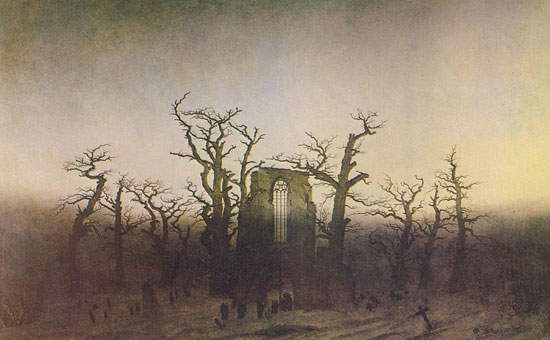 |
| Caspar David Friedrich, Abbey in the Oak Grove(Abtei im Eichwald); 1809-1810; Berlin, Alte Nationalgalerie |
But the cues that can be grasped do not end there. Indeed, the forest in Fantasia recalls, very closely, a painting by Friedrich that we find in the Niedersächsisches Landesmuseum in Hanover, the Evening:
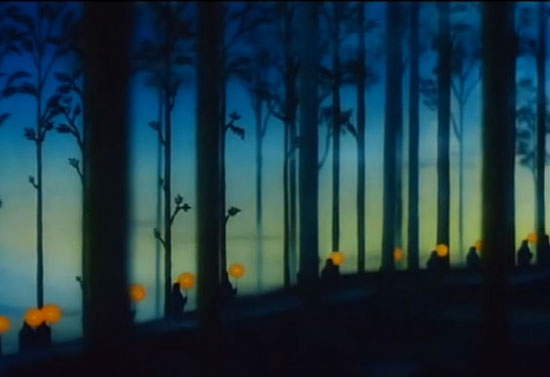 |
| The Forest from the film Fantasia, with the procession of monks |
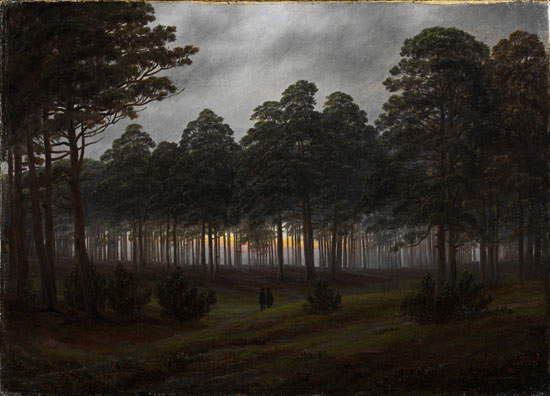 |
| Caspar David Friedrich, The Evening(Der Abend); 1821; Hanover, Niedersächsisches Landesmuseum |
Toward the end of the Walt Disney-produced film, the shot travels through the entire church in the dark and reaches the central window of theapse: from there, it then moves outdoors and back onto the forest. The film ends with a few frames showing us the sun rising over the hills and flooding the vegetation with red light. The moment when the frame shifts from the church window to the forest reminds us of another painting by Friedrich, the Dreamer:
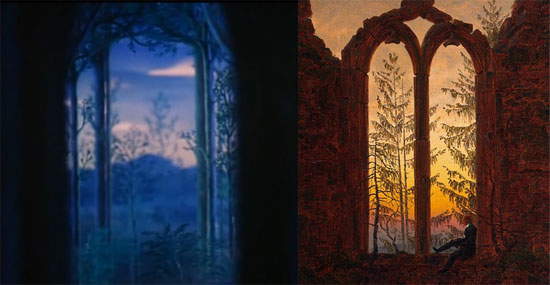 |
| Comparison of Fantasia and the Dreamer(Der Träumer) by Caspar David Friedrich (ca. 1835; St. Petersburg, Hermitage) |
All these quotations have a definite origin. The art director of the last episodes of the film(Night on Bald Mountain and Ave Maria, to be clear) was Kay Nielsen (1886 - 1957), a Danish illustrator who trained by studying the very works of the Romantic painters and Symbolists. His graphic work, in fact, is also greatly influenced by suggestions from a reading of the art of Caspar David Friedrich. In 1914, he found himself illustrating a book of Norwegian fairy tales, East of the Sun and West of the Moon. One of the illustrations in the book is this:
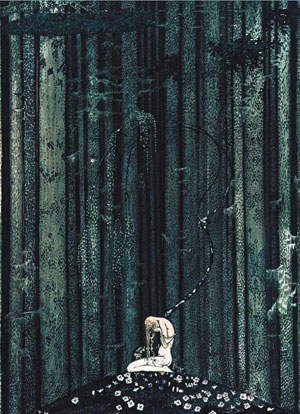 |
| Kay Nielsen, Illustration for East of the Sun and West of the Moon. |
Kay Nielsen soon became one of the most famous illustrators of his time, so much so that Disney specifically wanted him for its film Fantasia (which, let us remember, was released in theaters in 1940). Nielsen accepted and gave his stylistic signature to the last two episodes of the film. Thus succeeding in making the film evoke the atmosphere of the paintings of Caspar David Friedrich: the author whom Nielsen had greatly studied and appreciated. Pay attention to it next time you watch the film :-)
Warning: the translation into English of the original Italian article was created using automatic tools. We undertake to review all articles, but we do not guarantee the total absence of inaccuracies in the translation due to the program. You can find the original by clicking on the ITA button. If you find any mistake,please contact us.




























